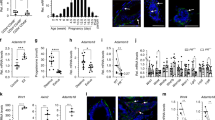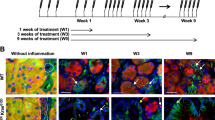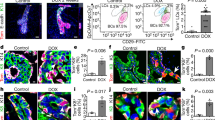Abstract
Both ErbB1 and ErbB2 are overexpressed or amplified in breast tumours. To examine the effects of activating ErbB receptors in a context that mimics polarized epithelial cells in vivo, we activated ErbB1 and ErbB2 homodimers in preformed, growth-arrested mammary acini cultured in three-dimensional basement membrane gels. Activation of ErbB2, but not that of ErbB1, led to a reinitiation of cell proliferation and altered the properties of mammary acinar structures. These altered structures share several properties with early-stage tumours, including a loss of proliferative suppression, an absence of lumen, retention of the basement membrane and a lack of invasive properties. ErbB2 activation also disrupted tight junctions and the cell polarity of polarized epithelia, whereas ErbB1 activation did not have any effect. Our results indicate that ErbB receptors differ in their ability to induce early stages of mammary carcinogenesis in vitro and this three-dimensional model system can reveal biological activities of oncogenes that cannot be examined in vitro in standard transformation assays.
This is a preview of subscription content, access via your institution
Access options
Subscribe to this journal
Receive 12 print issues and online access
$209.00 per year
only $17.42 per issue
Buy this article
- Purchase on SpringerLink
- Instant access to full article PDF
Prices may be subject to local taxes which are calculated during checkout






Similar content being viewed by others
References
Petersen, O. W., Ronnov-Jessen, L., Howlett, A. R. & Bissell, M. J. Interaction with basement membrane serves to rapidly distinguish growth and differentiation pattern of normal and malignant human breast epithelial cells. Proc. Natl Acad. Sci. USA 89, 9064–9068 (1992). (Erratum, Proc. Natl Acad. Sci. USA 90, 2556 (1993).)
Weaver, V. M. et al. Reversion of the malignant phenotype of human breast cells in three-dimensional culture and in vivo by integrin blocking antibodies. J. Cell Biol. 137, 231–245 (1997).
Harris, J., Lippman, M., Morrow, M. & Osborne, C. Diseases of the Breast (Lippincott Williams and Wilkins, Philadelphia, 1999).
Olayioye, M. A., Neve, R. M., Lane, H. A. & Hynes, N. E. The ErbB signaling network: receptor heterodimerization in development and cancer. EMBO J. 19, 3159–3167 (2000).
Riese, D. J. 2nd & Stern, D. F. Specificity within the EGF family/ErbB receptor family signaling network. BioEssays 20, 41–48 (1998).
Alroy, I. & Yarden, Y. The ErbB signaling network in embryogenesis and oncogenesis: signal diversification through combinatorial ligand–receptor interactions. FEBS Lett. 410, 83–86 (1997).
Harari, D. & Yarden, Y. Molecular mechanisms underlying ErbB2/HER2 action in breast cancer. Oncogene 19, 6102–6114 (2000).
Hynes, N. E. & Stern, D. F. The biology of erbB-2/neu/HER-2 and its role in cancer. Biochim. Biophys. Acta 1198, 165–184 (1994).
Di Fiore, P. P. et al. erbB-2 is a potent oncogene when overexpressed in NIH/3T3 cells. Science 237, 178–182 (1987).
Di Fiore, P. P. et al. EGF receptor and erbB-2 tyrosine kinase domains confer cell specificity for mitogenic signaling. Science 248, 79–83 (1990).
Di Marco, E., Pierce, J. H., Knicley, C. L. & Di Fiore, P. P. Transformation of NIH 3T3 cells by overexpression of the normal coding sequence of the rat neu gene. Mol. Cell. Biol. 10, 3247–3252 (1990).
Samanta, A. et al. Ligand and p185c-neu density govern receptor interactions and tyrosine kinase activation. Proc. Natl Acad. Sci. USA 91, 1711–1715 (1994).
Gullick, W. J. & Srinivasan, R. The type 1 growth factor receptor family: new ligands and receptors and their role in breast cancer. Breast Cancer Res. Treat. 52, 43–53 (1998).
Muthuswamy, S. K., Gilman, M. & Brugge, J. S. Controlled dimerization of ErbB receptors provides evidence for differential signaling by homo- and heterodimers. Mol. Cell. Biol. 19, 6845–6857 (1999).
Soule, H. D. et al. Isolation and characterization of a spontaneously immortalized human breast epithelial cell line, MCF-10. Cancer Res. 50, 6075–6086 (1990).
Amara, J. F. et al. A versatile synthetic dimerizer for the regulation of protein–protein interactions. Proc. Natl Acad. Sci. USA 94, 10618–10623 (1997).
Borg, J. P. et al. ERBIN: a basolateral PDZ protein that interacts with the mammalian ERBB2/HER2 receptor. Nature Cell Biol. 2, 407–414 (2000).
Hobert, M. & Carlin, C. Cytoplasmic juxtamembrane domain of the human EGF receptor is required for basolateral localization in MDCK cells. J. Cell Physiol. 162, 434–446 (1995).
Basolo, F. et al. Transformation of human breast epithelial cells by c-Ha-ras oncogene. Mol. Carcinog. 4, 25–35 (1991).
Howlett, A. R. et al. Cellular growth and survival are mediated by β1 integrins in normal human breast epithelium but not in breast carcinoma. J. Cell Sci. 108, 1945–157 (1995).
Streuli, C. H. & Gilmore, A. P. Adhesion-mediated signaling in the regulation of mammary epithelial cell survival. J. Mammary Gland Biol. Neoplasia 4, 183–191 (1999).
Wodarz, A. Tumor suppressors: linking cell polarity and growth control. Curr. Biol. 10, R624–R626 (2000).
Collins, M. K. et al. Transfer of functional EGF receptors to an IL3-dependent cell line. J. Cell. Physiol. 137, 293–298 (1988).
Reichmann, E. et al. Activation of an inducible c-FosER fusion protein causes loss of epithelial polarity and triggers epithelial-fibroblastoid cell conversion. Cell 71, 1103–1116 (1992).
Fialka, I. et al. The estrogen-dependent c-JunER protein causes a reversible loss of mammary epithelial cell polarity involving a destabilization of adherens junctions. J. Cell Biol. 132, 1115–1132 (1996).
Schoenenberger, C. A., Zuk, A., Kendall, D. & Matlin, K. S. Multilayering and loss of apical polarity in MDCK cells transformed with viral K-ras. J. Cell Biol. 112, 873–889 (1991).
Spancake, K. M. et al. E7-transduced human breast epithelial cells show partial differentiation in three-dimensional culture. Cancer Res. 59, 6042–6045 (1999).
Blatchford, D. R. et al. Influence of microenvironment on mammary epithelial cell survival in primary culture. J. Cell. Physiol. 181, 304–311 (1999).
Boudreau, N., Sympson, C. J., Werb, Z. & Bissell, M. J. Suppression of ICE and apoptosis in mammary epithelial cells by extracellular matrix. Science 267, 891–893 (1995).
Frisch, S. M. & Ruoslahti, E. Integrins and anoikis. Curr. Opin. Cell Biol. 9, 701–706 (1997).
Baeckstrom, D., Alford, D. & Taylor-Papadimitriou, J. Morphogenetic and proliferative responses to heregulin of mammary epithelial cells in vitro are dependent on HER2 and HER3 and differ from the responses to HER2 homodimerisation or hepatocyte growth factor. Int. J. Oncol. 16, 1081–1090 (2000).
Chausovsky, A. et al. Molecular requirements for the effect of neuregulin on cell spreading, motility and colony organization. Oncogene 19, 878–888 (2000).
Spencer, K. S. et al. ErbB2 is necessary for induction of carcinoma cell invasion by ErbB family receptor tyrosine kinases. J. Cell Biol. 148, 385–397 (2000).
Keely, P. J. et al. Cdc42 and Rac1 induce integrin-mediated cell motility and invasiveness through PI(3)K. Nature 390, 632–636 (1997).
Vleminckx, K. et al. Genetic manipulation of E-cadherin expression by epithelial tumor cells reveals an invasion suppressor role. Cell 66, 107–119 (1991).
D'Souza, B. & Taylor-Papadimitriou, J. Overexpression of ERBB2 in human mammary epithelial cells signals inhibition of transcription of the E-cadherin gene. Proc. Natl Acad. Sci. USA 91, 7202–7206 (1994).
Ciardiello, F. et al. Transforming growth factor-α expression is enhanced in human mammary epithelial cells transformed by an activated c-Ha-ras protooncogene but not by the c-neu protooncogene, and overexpression of the transforming growth factor-α complementary DNA leads to transformation. Cell Growth Differ. 1, 407–420 (1990).
Giunciuglio, D. et al. Invasive phenotype of MCF10A cells overexpressing c-Ha-ras and c-erbB-2 oncogenes. Int. J. Cancer 63, 815–822 (1995).
Harris, R. A. et al. New model of ErbB-2 over-expression in human mammary luminal epithelial cells. Int. J. Cancer 80, 477–484 (1999).
D'Souza, B., Berdichevsky, F., Kyprianou, N. & Taylor-Papadimitriou, J. Collagen-induced morphogenesis and expression of the α2-integrin subunit is inhibited in c-erbB2-transfected human mammary epithelial cells. Oncogene 8, 1797–1806 (1993).
Pierce, J. H. et al. Oncogenic potential of erbB-2 in human mammary epithelial cells. Oncogene 6, 1189–1194 (1991).
Lucassen, E. et al. The effects of the neuN and neuT genes on differentiation and transformation of mammary epithelial cells. J. Cell Sci. 107, 2919–2929 (1994).
Normanno, N. et al. Amphiregulin as an autocrine growth factor for c-Ha-ras- and c-erbB-2-transformed human mammary epithelial cells. Proc. Natl Acad. Sci. USA 91, 2790–2794 (1994).
Niemann, C. et al. Reconstitution of mammary gland development in vitro: requirement of c-met and c-erbB2 signaling for branching and alveolar morphogenesis. J. Cell Biol. 143, 533–545 (1998).
Ory, D. S., Neugeboren, B. A. & Mulligan, R. C. A stable human-derived packaging cell line for production of high titer retrovirus/vesicular stomatitis virus G pseudotypes. Proc. Natl Acad. Sci. USA 93, 11400–11406 (1996).
Miranti, C. K., Ohno, S. & Brugge, J. S. Protein kinase C regulates integrin-induced activation of the extracellular regulated kinase pathway upstream of Shc. J. Biol. Chem. 274, 10571–10581 (1999).
Khoury, H. et al. Distinct tyrosine autophosphorylation sites mediate induction of epithelial mesenchymal like transition by an activated ErbB-2/Neu receptor. Oncogene 15, 786–799 (2001).
Acknowledgements
We thank ARIAD Pharmaceuticals for providing AP1510 (see http://www.ariad.com for more information); Terry Keenan for synthesis of AP1510; Tim Clackson and Victor Rivera for helpful discussions; William Muller for ErbB2 cDNA; Robert Burgeson for anti-laminin V antibodies; Richard Mulligan for the 293-GPG retrovirus packaging cell line; Carolyn Damsky for AIIB2 antibodies; Karl Matlin for the MDCK cell line; and members of Brugge and Bissell laboratories for stimulating discussions and helpful suggestions. This work was supported by grants from NIH (NCI) (J.S.B., M.J.B.); US Army Medical Research and Material Command (S.K.M.), Massachusetts Breast Cancer Research (S.K.M.), and the US Department of Energy, Office of Biological and Environmental Research (M.J.B.).
Author information
Authors and Affiliations
Corresponding author
Supplementary information
Supplementary figures
Figure S1 Activation of ErbB2 homodimers was unable to induce anchorage-independent growth. (PDF 910 kb)
Figure S2 Activation of ErbB2 does not overcome b1 integrin requirement.
Figure S3 Activation of ErbB1 or ErbB2 was not sufficient to induce migration or invasion.
Rights and permissions
About this article
Cite this article
Muthuswamy, S., Li, D., Lelievre, S. et al. ErbB2, but not ErbB1, reinitiates proliferation and induces luminal repopulation in epithelial acini. Nat Cell Biol 3, 785–792 (2001). https://doi.org/10.1038/ncb0901-785
Received:
Revised:
Accepted:
Published:
Issue Date:
DOI: https://doi.org/10.1038/ncb0901-785
This article is cited by
-
Anoikis resistance––protagonists of breast cancer cells survive and metastasize after ECM detachment
Cell Communication and Signaling (2023)
-
Nucleocytoplasmic transport of active HER2 causes fractional escape from the DCIS-like state
Nature Communications (2023)
-
MicroRNAs as the critical regulators of cell migration and invasion in thyroid cancer
Biomarker Research (2022)
-
Her2 promotes early dissemination of breast cancer by suppressing the p38 pathway through Skp2-mediated proteasomal degradation of Tpl2
Oncogene (2020)
-
Cell polarity and oncogenesis: common mutations contribute to altered cellular polarity and promote malignancy
The Nucleus (2020)



